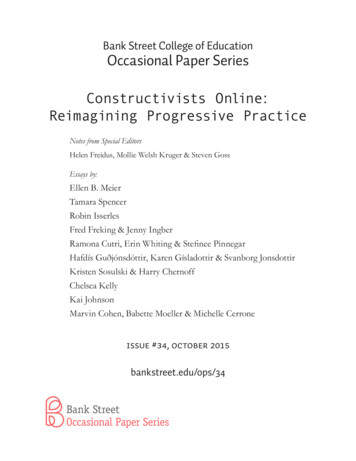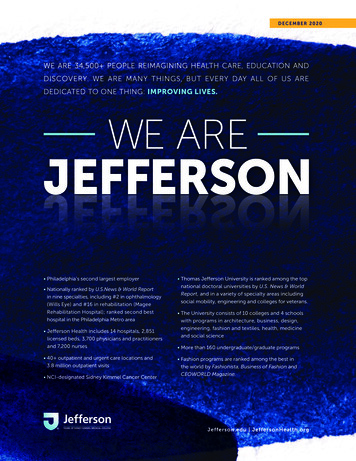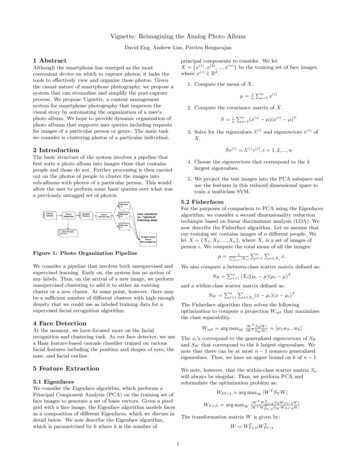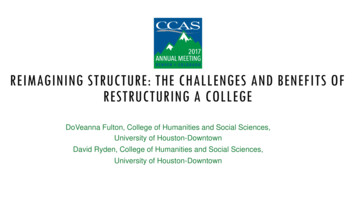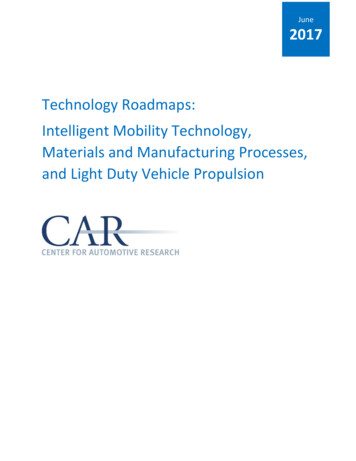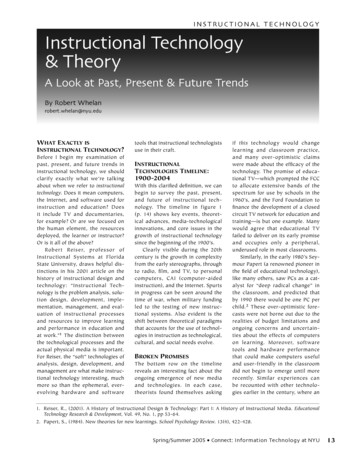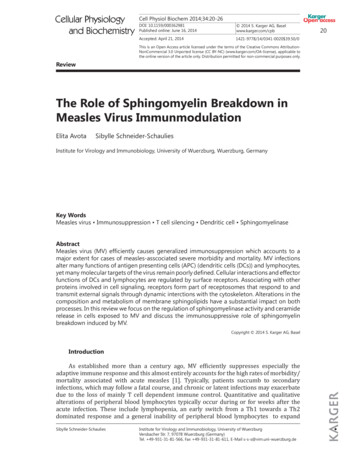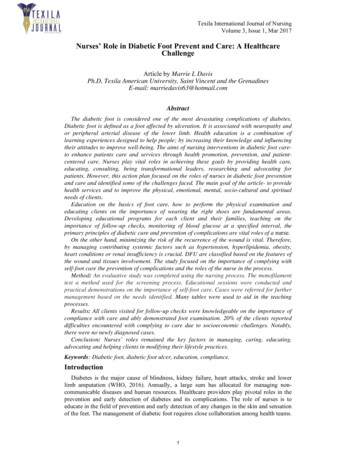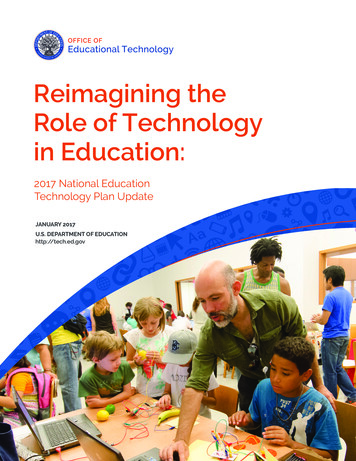
Transcription
Reimagining theRole of Technologyin Education:2017 National EducationTechnology Plan UpdateJANUARY 2017U.S. DEPARTMENT OF EDUCATIONhttp://tech.ed.gov1
ContentsLetter from the Director 1Introduction 3About this Plan 3Recent Progress and the Road Ahead 7Section I: Learning —Engaging and Empowering Learning through Technology9What People Need to Learn 10Technology-Enabled Learning in Action 12The Future of Learning Technologies 18Bringing Equity to Learning Through Technology20Providing Technology Accessibility for All Learners21Physical Spaces and Technology-Enabled Learning23Recommendations 25Section 2: Teaching—Teaching With Technology 28Roles and Practices of Educators in Technology-Supported Learning29Connected Educators: Exemplars 33Rethinking Teacher Preparation 35Fostering Ongoing Professional Learning 37Recommendations 40Section 3: Leadership—Creating a Culture and Conditions for Innovation and Change42Characteristics of Effective Leadership43Future Ready Leaders 43Implementation is Key 46Budgeting and Funding for the Transition to Digital Learning48Recommendations 53Section 4: Assessment—Measuring for Learning 55Approaches to Assessment 57Using Assessment Data to Support Learning57How Technology Transforms Assessment 58The Future of Technology-Based Assessment 63Recommendations 67
Section 5: Infrastructure—Enabling Access and Effective Use69Ubiquitous Connectivity 72Powerful Learning Devices 76High-Quality Digital Learning Content 76Responsible Use Policies (RUP) 78Protections for Student Data and Privacy79Device and Network Management 81Recommendations 83Conclusion 85Challenges Remain 85We Already Have Begun 86Recommendations 87Appendix A. Future Ready Resources 92Appendix B. Acknowledgments 100Project Team 100Technical Working Group 100Interviews 101Outreach Events 103Target Virtual Outreach 103External Reviewers 104Appendix C. The Development of the 2016 NETP105
NETP DevelopmentSupport for the creation of this document was provided by the American Institutes for Researchunder the contract ED-04-CO-0040/0010.U.S. Department of EducationJohn KingSecretaryOffice of Educational TechnologyJoseph SouthDirectorKatrina StevensDeputy DirectorJanuary 2017Version 2.0Examples Are Not EndorsementsThis document contains examples and resource materials that are provided for the user’sconvenience. The inclusion of any material is not intended to reflect its importance, nor is itintended to endorse any views expressed, or products or services offered. These materials maycontain the views and recommendations of various subject matter experts as well as hypertextlinks, contact addresses and websites to information created and maintained by other publicand private organizations. The opinions expressed in any of these materials do not necessarilyreflect the positions or policies of the U.S. Department of Education. The U.S. Department ofEducation does not control or guarantee the accuracy, relevance, timeliness, or completeness ofany outside information included in these materials.Licensing and AvailabilityThis report is in the public domain. Authorization to reproduce this report in whole or in partis granted. While permission to reprint this publication is not necessary, the suggested citationis: U.S. Department of Education, Office of Educational Technology, Reimagining the Role ofTechnology in Education: 2017 National Education Technology Plan Update, Washington, D.C.,2017.This report is available on the Department’s Website at http://tech.ed.gov.Requests for alternate format documents such as Braille or large print should be submitted to theAlternate Format Center by calling 202-260-0852 or by contacting the 504 coordinator via emailat om eeos@ed.gov.Notice to Limited English Proficient PersonsIf you have difficulty understanding English you may request language assistance servicesfor Department information that is available to the public. These language assistance servicesare available free of charge. If you need more information about interpretation or translationservices, please call 1-800-USA-LEARN (1- 800-872-5327) (TTY: 1-800-437-0833), or email usat: Ed.Language.Assistance@ed.gov. Or write to: U.S. Department of Education, InformationResource Center, LBJ Education Building, 400 Maryland Ave. SW, Washington, DC 20202.Cover photo credit Hive NYC/Brooklyn Public Library
Letter fromthe DirectorAbout the 2017 UpdateIn just one year since the release of the 2016 NETP, we have seen rapid change across the country in fundamental aspects of the educational technology landscape. These changes include thenumber of schools that that have access to broadband in their classrooms; the types and costof technology available to schools; an evolution in the approach of leaders to the procurementof ed tech solutions as well as a greater emphasis on data security and digital citizenship; theadvent of new research on the use of technology by early learners; and an increased emphasison preparing teachers to lead with technology before they arrive in the classroom.In order to keep pace with the changes we are seeing in schools, districts, and states on analmost daily basis, we also need to change how often the National Education Technology Planis updated. Feedback from our stakeholders indicates that the previous five year update cyclewas not frequent enough. In response, with this 2017 update, we commence a pattern of yearly,smaller scale updates to the NETP to better account for the pace of innovation in the field.As part of the 2017 update, the reader will learn that: We are encouraged by the fact that most classrooms in our country now have access tobroadband, yet we know that many that do not are in communities where the potentialimpact is the greatest.We welcome lower price points for devices designed for school use, but also lament that mosted tech purchases are still based on word of mouth rather than evidence of effectiveness.We look forward to a greater emphasis on the use of evidence as outlined within the reauthorization of the Elementary and Secondary Education Act (ESEA), as amended by EveryStudent Succeeds Act (ESSA), yet recognize that educators will need assistance in expandingtheir efforts to infuse an evidence-based culture when it comes to ed tech in their schoolsand classrooms.We are pleased to find that, in some districts, librarians and teacher leaders are stepping intomore prominent leadership roles that leverage their existing skillsets to lead their peers inpedagogically driven classroom technology use. Yet we also see library positions cut back inother districts as a cost saving measure and the under utilization of classroom teachers asleaders of digital change.We are proud of the growing number of students who work with teachers and peers tobecome responsible digital citizens in their schools, yet recognize that many low-income students, especially in urban and rural areas, lack internet access at home to complete their digital homework assignments and to use powerful digital tools at home to create, to solve, andto communicate that their better-off peers across town take for granted.We are eager to take a step forward in understanding and recognizing how the active use oftechnology by early learners with adults can positively impact them, yet are concerned bythe number of children left alone for long periods of time with a passive digital babysitter.OFFICE OF EducationalTechnology1
And we applaud those who are increasing their efforts to prepare pre-service and in-serviceteachers to use technology in transformative ways for learning. Yet we know that almost half ofour teachers desire more training than they currently receive in using technology effectively.Against this backdrop, it is now more apparent than ever that the courageous efforts of educators to embrace the role of thoughtful, reflective innovators who work collaboratively witheach other and alongside their students to explore new learning models, new digital learningenvironments, and new approaches to working, learning, and sharing is essential if we wanttechnology to be an effective tool to transform learning.We hope you will take that journey with us!Joseph SouthDirector, Office of Educational TechnologyUS Department of EducationOFFICE OF EducationalTechnology2
IntroductionOne of the most important aspects of technology in education is its abilityto level the field of opportunity for students.—John King, U.S. Secretary of EducationTechnology can be a powerful tool for transforming learning. It can help affirm and advancerelationships between educators and students, reinvent our approaches to learning and collaboration, shrink long-standing equity and accessibility gaps, and adapt learning experiences tomeet the needs of all learners.Our schools, community colleges, adult learning centers and universities should be incubators of exploration and invention. Educators should be collaborators in learning, seeking newknowledge and constantly acquiring new skills alongside their students. Education leadersshould set a vision for creating learning experiences that provide the right tools and supportsfor all learners to thrive.However, to realize fully the benefits of technology in our education system and provideauthentic learning experiences, educators need to use technology effectively in their practice.Furthermore, education stakeholders should commit to working together to use technology toimprove American education. These stakeholders include leaders; teachers, faculty, and othereducators; researchers; policymakers; funders; technology developers; community membersand organizations; and learners and their families.The Higher Education Supplement to the NETP — a separate, complementary document —builds on the principles described in each of the NETP’s five sections-- learning, teaching,assessment, and infrastructure-- examining them in the context of the higher education ecosystem. It examines the role of technology in serving an increasingly diverse and dispersed student body that is growing and evolving in size and composition and discusses the various waysthat technology can enable system- and ecosystem-wide applications of collaborative solutionsto systemic issues of access, affordability, and completion.This 2017 update to the NETP is the first yearly update in the history of the plan. Feedbackfrom the field indicated that the previous five-year update cycle was not frequent enough toaccount for rapidly changing circumstances and the pace of technology advancement in ourschools. It is our intention to continue yearly updates to the NETP.About This PlanThe National Education Technology Plan (NETP) sets a national vision and plan for learningenabled by technology through building on the work of leading education researchers; district,school, and higher education leaders; classroom teachers; developers; entrepreneurs; andnonprofit organizations. The principles and examples provided in this document align to theActivities to Support the Effective Use of Technology (Title IV) Part A of the ESEA, as amendedby ESSA.OFFICE OF EducationalTechnology3
THE NETP IS.a callto actiona vision for learningenabled throughtechnologya collectionof recommendations& real-world examplesWRITTEN FOR.TeachersPolicymakersAdministratorsTeacher preparationprofessionalsMAKING POSSIBLE .EVERYWHERE, ALL-THE-TIME LEARNINGDINEROFFICE OF EducationalTechnology4
To illustrate key ideas and recommendations, the plan includes examples ofthe transformation enabled by the effective use of technology. These examplesinclude both those backed by rigorous evidence as well as emerging innovations.The identification of specific programs or products in these examples is designedto provide a clearer understanding of innovative ideas and is not meant as anendorsement. The NETP also provides actionable recommendations to implementtechnology and conduct research and development successfully that can advancethe effective use of technology to support learning and teaching.Intended to be useful for any group or individual with a stake in education, theNETP assumes as its primary audiences teachers; education leaders; those responsible for preparing teachers; and policymakers at the federal, state, and local levels. The concepts, recommendations, and examples are also applicable to postsecondary institutions, community organizations, and state-level initiatives. TheNETP focuses on using technology to transform learning experiences with thegoal of providing greater equity and accessibility (see Section 1: Learning).When carefully designed and thoughtfully applied, technology can accelerate,amplify, and expand the impact of effective teaching practices. However, to betransformative, educators need to have the knowledge and skills to take fulladvantage of technology-rich learning environments (see Section 2: Teaching).In addition, the roles of PK–12 classroom teachers and postsecondary instructors, librarians, families, and learners all will need to shift as technologyenables new types of learning experiences.For these systemic changes in learning and teaching to occur, education leaders need to create a shared vision for how technology best can meet the needsof all learners and to develop a plan that translates the vision into action (seeSection 3: Leadership).Technology-enabled assessments support learning and teaching by communicating evidence of learning progress and providing insights to teachers;administrators; families; and, most importantly, the learners themselves. Theseassessments can be embedded within digital learning1 activities to reduce interruptions to learning time (see Section 4: Assessment).Learning, teaching, and assessment enabled by technology require a robustinfrastructure (see Section 5: Infrastructure). Key elements of this infrastructureinclude high-speed connectivity and devices that are available to teachers andstudents when they need them. Aside from wires and devices, a comprehensivelearning infrastructure includes digital learning content and other resources aswell as professional development for educators and education leaders.OFFICE OF EducationalTechnologyEQUITY ANDACCESSIBILITYEquity in education meansincreasing all students’ access toeducational opportunities witha focus on closing achievementgaps and removing barriers thatstudents face based on theirrace, ethnicity, or national origin;sex; sexual orientation or genderidentity or expression; disability;English language ability; religion; socioeconomic status; orgeographical location. 2Accessibility refers to the designof apps, devices, materials, andenvironments that support andenable access to content andeducational activities for alllearners. In addition to enablingstudents with disabilities touse content and participate inactivities, the concepts also applyto accommodating the individuallearning needs of students, suchas English language learners,students in rural communities,or from economically disadvantaged homes. Technology cansupport accessibility throughembedded assistance, forexample, text-to-speech, audioand digital text formats of instructional materials, programs thatdifferentiate instruction, adaptivetesting, built-in accommodations,and assistive technology.5
FITTING THEPIECES TOGETHERaccessibilityresourcesLEADERSHIPSetting the visionASSESSMENTUnderstandinglearning progressLEARNINGTEACHINGPutting visioninto practiceconnectivitydevicesINFRASTRUCTUREProviding accessibility, resources and connectivity so that learning iseverywhere, all the timeOFFICE OF EducationalTechnology6
Recent Progress and the Road AheadSince the 2010 NETP, the U.S. has made significant progress in leveragingtechnology to transform learning in a variety of ways: The conversation has shifted from whether technology should be used inlearning to how it can improve learning to ensure that all students haveaccess to high-quality educational experiences.3Technology increasingly is being used to personalize learning and give students more choice over what and how they learn and at what pace, preparingthem to organize and direct their own learning for the rest of their lives.Advances in the learning sciences have improved our understanding of howpeople learn and have illuminated which personal and contextual factorsmost impact their success.Research and experience have improved our understanding of what peopleneed to know and the skills and competencies they need to acquire for success in life and work in the 21st century. Through pre-service teacher preparation programs and professional learning, educators are gaining experienceand confidence in using technology to achieve learning outcomes.Sophisticated software has begun to allow us to adapt assessments andinstruction to the needs and abilities of individual learners and provide nearreal-time results.Nationally, significant progress has been made toward ensuring that everyschool has high-speed classroom connectivity as a foundation for other learning innovations.The cost of digital devices has decreased dramatically, while computingpower has increased, along with the availability of high-quality interactiveeducational tools and apps.Technology has allowed us to rethink the design of physical learning spacesto accommodate new and expanded relationships among learners, teachers,peers, and mentors.Although we can be proud of the progress of the last six years, there is still muchwork to do. Now, a look at the work ahead: A digital use divide continues to exist between learners who are usingtechnology in active, creative ways to support their learning and thosewho predominantly use technology for passive content consumption.While school and district leaders often leverage data for decision-making,many still need support and better tools so they can get real-time information on how strategies are working through rigorous, quick-turnaroundevaluations of technology.Many schools do not yet have access to or are not yet using technology inways that can improve learning on a daily basis, which underscores theneed—guided by new research—to accelerate and scale up adoption ofeffective approaches and technologies.Schools and districts that are deciding how to incorporate educationaltechnology in student learning should actively involve and engagefamilies during early development and implementation of their digitaltransformation.OFFICE OF EducationalTechnologyDIGITAL USEDIVIDETraditionally, the digital dividereferred to the gap betweenstudents who had access to theInternet and devices at schooland home and those who didnot.5,6 Significant progress isbeing made to increase internetaccess in schools, libraries,and homes across the country.However, a digital use divideseparates many students whouse technology in ways thattransform their learning fromthose who use the tools tocomplete the same activities butnow with an electronic device(e.g., digital worksheets, onlinemultiple-choice tests). The digitaluse divide is present in both formal and informal learning settingsand across high- and low-povertyschools and communities.7,8,97
Few schools have adopted approaches for using technology to supportinformal learning experiences aligned with formal learning goals.Supporting learners in using technology for out-of-school learning experiences is often a missed opportunity.Many pre-service teacher education graduates feel unprepared to usetechnology to support student learning as they transition to teaching andusing technology effectively in the classrooms.4Assessment approaches have evolved but still do not use technology to itsfull potential to measure a broad
Roles and Practices of Educators in Technology-Supported Learning 29 Connected Educators: Exemplars 33 Rethinking Teacher Preparation 35 . We are eager to take a step forward in understanding and recognizing how the active use of technology by early learners with ad
